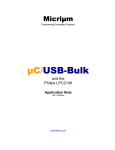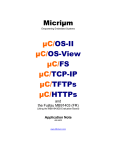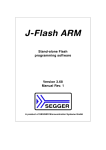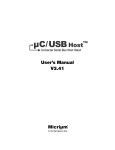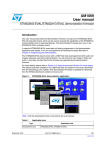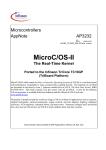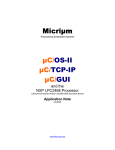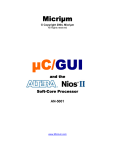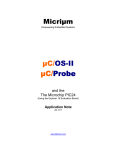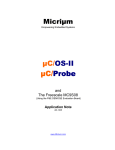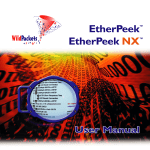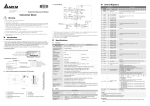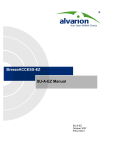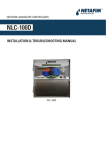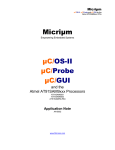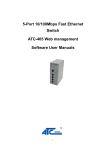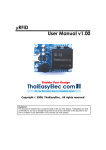Download 開啟原PDF
Transcript
Micriµm
© Copyright 2005-2007, Micriµm
All Rights reserved
µC/TTCP
Test TCP
User’s Manual
www.Micrium.com
Empowering Embedded Systems
1
Table of Contents
1.00
Introduction
1.01
Directories and Files
2.00
Network setup
3.00
PCATTCP
3.01
Network Analyzer (Sniffer)
4.00
µC/TTCP
4.01
µC/TTCP command line
4.02
TCP Transmit Test
4.03
TCP Receive Test
4.04
UDP Transmit Test
4.05
UDP Receive Test
5.00
µC/TTCP
5.01
TTCP Code, ttcp.c
5.02
TTCP startup code : main()
5.03
TTCP startup code : AppStartTask()
6.00
µC/TTCP module limitations
6.01
IP transmit fragmentation
6.02
Target performance
References
Contacts
3
3
5
6
7
8
8
10
12
14
16
18
18
19
20
21
21
21
22
22
2
1.00
Introduction
Test TCP or TTCP, is a test tool to perform TCP/IP or UDP/IP performance tests. TTCP is a commandline sockets-based benchmarking tool for measuring performance between two systems. It was originally
developed in 1984 by Mike Muuss and Terry Slattery for the BSD operating system. The original TTCP
and sources are in the public domain, and copies are available from many anonymous FTP sites.
This document describes how to configure and use the µC/TTCP module in a µC/TCP-IP and µC/OS-II
environment.
We used the Cogent CSB337 single-board computer and IAR’s Embedded Workbench to demonstrate
the examples but other embedded platforms and tool chains can be used.
1.01
Directories and Files
The code and documentation of the µC/TTCP module are placed in a directory structure according to
“AN-2002, µC/OS-II Directory Structure”. Specifically, the files are placed in the following directories:
\Micrium\Software\uC-TTCP\Doc
This directory contains the µC/TTCP documentation files, including this one.
\Micrium\Software\uC-TTCP\Source
This directory contains the µC/TTCP source files (ttcp.c and ttcp.h).
\Micrium\Software\uC-LIB
This directory contains the µC/LIB source files, the Micrium version of the C library most used
utilities. The goal of this library is to ease a certification process by providing the source code and
documentation for all the functions. This directory contains:
lib_def.h
lib_mem.c
lib_mem.h
lib_str.c
lib_str.h
\Micrium\Software\uC-CPU
This directory contains the µC/CPU source files (cpu_def.h). This file provides definition for
byte alignment, endianess and critical section handling.
\Micrium\Software\uC-CPU\ARM\IAR
This directory contains the files to configure standard data types, cpu word configuration, critical
section configuration and cpu data types for the IAR compiler used for this sample project.
(cpu.h and cpu_a.s)
\Micrium\Software\EvalBoards\Cogent\CSB337\IAR\uC-APPs\Ex1
This directory contains the source code for Example #1 running on a Cogent CSB337 with IAR
tools. This directory contains:
app_cfg.c
includes.h
net_cfg.h
os_cfg.h
3
•
•
•
•
app_cfg.c contains the application OS task priorities and stack space;
includes.h contains a master include file used by the application;
net_cfg.h is the µC/TCP-IP configuration file;
os_cfg.h is the µC/OS-II configuration file;
This directory also contains the IAR EWARM 4.31a project workspace files:
Ex1.ewd
Ex1.ewp
Ex1.eww
\Micrium\Software\EvalBoards\Cogent\CSB337\IAR\BSP
This directory contains the Board Support Package (BSP) files and linker file for the project and
target development board used for the example used to demonstrate TTCP. This directory
contains:
bsp.c
bsp.h
CSB33z_lnk_ram.xcl
net_bsp.c
•
•
•
•
bsp.c contains the board support functions for Interrupts, Timers, LEDs and Serial port;
bsp.h contains the header definition for bsp.c;
CSB33x_lnk_ram.xcl is the linker file for the IAR tool;
net_bsp.c contains the low level interface functions for the Ethernet controller used in the sample
project;
4
2.00
Network setup
Even if TTCP stands for Test TCP, the TTCP module can perform the following tests:
•
•
•
•
Transmitting TCP segments
Receiving TCP segments
Transmitting UDP datagrams
Receiving UDP datagrams
: also called TCP Client mode
: also called TCP Server mode
: also called UDP Client mode
: also called UDP Server mode
TTCP always work in a peer to peer configuration.
In developing µC/TTCP we were always running on a Cogent CSB337 and we were using PCATTCP on
a PC.
Ethernet Hub or Switch
F2-1
Network set-up
`
Windows system
PCATTCP and Packet Capture (Sniffer)
10.10.10.101
RS-232
Cogent CSB337
10.10.10.64
JTAG
`
Development system
Debugger and Termnial Window
The target system is running Micrium µC/TTCP.
The Windows station also needs to run a TTCP application. The next section describes the Windows
TTCP implementation Micrium has selected.
5
3.00
PCATTCP
For our development, Micrium has selected the PCAUSA port of TTCP to Windows Sockets for the TTCP
module running on the Windows host. It is called pcattcp. It is not part of the official release, but you can
download it from Micrium’s web site and put it in the directory:
\Micrium\Software\uC-TTCP\pcattcp
This directory should then contain the following files:
PCATTCP.chm
PCATTCP.exe
RELEASE.TXT
sourcesv2.zip
ttcpzip.exe
•
•
•
•
•
PCATTCP.chm is the pcattcp html help file;
PCATTCP.exe is the tool itself;
RELEASE.TXT contains release information for the pcattcp versions;
sourcesv2.zip is a winzip file containing the pcattcp sources;
ttcpzip.exe a self-extract zip file containing the 4 files above (the download result).
You can also download pcattcp from ftp://ftp.pcausa.com/utilities/ttcpzip.exe
You will find more information about pcattcp at http://www.pcausa.com/Utilities/pcattcp.htm
Running pcattcp
•
•
•
•
Copy the content of ttcpzip.exe to a
directory (C:\pcattcp for example).
Open a DOS prompt window
Change directory to the directory now
containing pcattcp.exe
From the DOS prompt, start pcattcp:
C:\pcattcp>pcattcp
Without any arguments, pcattcp will output the
command usage. For more detailed
information about the pcattcp commands,
please refer to the html help file by double
clicking on PCATTCP.chm. This will
automatically open a help file.
F3-1
6
3.01
Network Analyzer (Sniffer)
In our test setup, we also used a Software based Network Analyzer (sometimes called a Sniffer). Micrium
used Etherpeek. Though you can see global network statistics without capturing packets, for some
analysis sessions you’ll want to capture packets.
Etherpeek is a commercial product of WildPackets Inc. To find more information about Etherpeek, please use the
following link: http://www.wildpackets.com/products/etherpeek_nx
Public domain Network Analyzers are also available. One of the most popular that we can also recommend is
Ethereal. You can download Ethereal from http://www.ethereal.com/
7
4.00
µC/TTCP
µC/TTCP is compliant with the other TTCP tools available in the public domain. It was written for target
systems running µC/OS-II and µC/TCP-IP. This section describes the µC/TTCP usage.
4.01
µC/TTCP command line
As soon as the application is launched on the target, via a JTAG interface or other means, the Terminal
Window running on the Development system will display the application status and a command line. The
user controls µC/TTCP by entering parameters on the command line.
The command usage is displayed if the user makes an error entering the command line or by pressing
ENTER at the “>” command prompt. Here is the command usage:
Usage: -t [-options] host
-r [-options]
Common options: \r\n");
-l ##
length of buffers read from or written to network (default 8192)
-u
use UDP instead of TCP
-p ##
port number to send to or listen at (default 5001)
-s -t: source a pattern to network
-r: sink (discard) all data from network
-d
set SO_DEBUG socket option (not supported)
-b ##
set socket buffer size (not supported)
-f X
format for rate: k,K = kilo{bit,byte}; m,M = mega; g,G = giga
Options specific to -t:
-n ##
number of source buffers written to network (default 2048)
-D
don't buffer TCP writes (sets TCP_NODELAY socket option)
Options specific to -r:
-B
for -s, only output full blocks as specified by -l
-T
"touch": access each byte as it is read
As an example, to start the TTCP TCP Receive Test start µC/TTCP with the "-r" option.
>-r
The TCP server will start and then wait until a remote TTCP client makes a connection attempt.
Instead of explaining all of the µC/TTCP options, we will be going through a few examples that illustrate
basic usage.
8
Sinkmode (-s)
The simplest and most popular TTCP mode of operation is called "sinkmode". In this mode of
operation the TTCP transmitter sends a fabricated data pattern and the TTCP receiver simply
sinks (discards) any data that it receives.
This is the default TTCP mode of operation.
Standard Streams
Alternatively, TTCP can use what is called "standard streams" or "standard I/O". With
µC/TTCP, the Serial port is used as the standard I/O.
Standard stream has only been implemented in Receiver mode. The code for Transmitter mode
still needs to be developed.
Defaults
The µC/TTCP defaults for the command parameters are:
Parameter
Value
Buffer Length
Number of buffers used
Transport layer protocol
Layer 4 port number
Receiver/Transmitter
Sink mode
Block read
Output format
8192
2048
TCP
5001
Receiver mode
Enabled
Disabled
'Kilobits per
second'
Disabled
Not supported
Not supported
Received data processing
Socket options
Buffer TCP writes
T4-1
9
Command
line
parameter
-l
-n
-u
-p
-r or –t
-s
-B
-f
-T
-d
-D
4.02
TCP Transmit Test
Target
To start the TTCP TCP Transmit Test start µC/TTCP with the "-t" option followed by the dotted IP address
of the remote TTCP client.
>-t 10.10.10.101
ttcp-t:
ttcp-t:
ttcp-t:
ttcp-t:
ttcp-t:
ttcp-t:
BufLen=8192, NumBuf=2048, port=5001 tcp -> 10.10.10.101
Client socket 9 opened
Client socket 9 connected
Client socket 9 closed
16777216 bytes in 41.87 real seconds = 3130.30 Kbit/sec +++
2099 I/O calls, msec/call = 19.95, calls/sec = 50.13
uC/TCP-IP Performance measurements
Type the TTCP parameters and parameter values and press Enter
>
These messages are generated as the test starts up:
ttcp-t: BufLen=8192, NumBuf=2048, port=5001 tcp
ttcp-t: Client socket 9 opened
-> 10.10.10.101
These messages indicate that a connection has been established with the remote host:
ttcp-t: Client socket 9 connected
When the test exits it displays the test results:
ttcp-t: Client socket 9 closed
ttcp-t: 16777216 bytes in 38.38 real seconds = 3415.38 Kbit/sec +++
ttcp-t: 2111 I/O calls, msec/call = 18.18, calls/sec = 55.01
As you can see all the default parameters are used:
• TCP is the default Layer 4 protocol used.
• Sinkmode is enabled by default
• Number of buffers : 2048
• Length of buffers : 8192
• TCP port
: 5001 (Note: public domain TTCP uses default port 5001. If a firewall blocks
this port, please choose another).
10
Windows host TTCP session
The Windows host running pcattcp must initiate the Receiver part of this test. Figure 4-1 shows the
command used:
F4-1
Windows host packet capture
Using Etherpeek, here is a screen shot of the Transmit test:
F4-2
11
4.03
TCP Receive Test
Target
To start the TTCP TCP Receive Test start µC/TTCP with the "-r" option.
>-r
The TCP receiver will start and then wait until a remote TTCP client makes a connection attempt. Here is
an example of the output you would see:
ttcp-r:
ttcp-r:
ttcp-r:
ttcp-r:
ttcp-r:
ttcp-r:
ttcp-r:
ttcp-r:
BufLen=8192, NumBuf=2048, port=5001 tcp
Listening socket opened = 9
Waiting for client to request connection.
Server socket 8 active
Client socket 8 closed
Listen socket 9 closed
16777216 bytes in 45.34 real seconds = 2891.06 Kbit/sec +++
9093 I/O calls, msec/call = 4.99, calls/sec = 200.56
uC/TCP-IP Performance measurements
Type the TTCP parameters, parameter values and press Enter
>
These messages are generated as the test starts up:
ttcp-r: BufLen=8192, NumBuf=2048, port=5001 tcp
ttcp-r: Listening socket opened = 9
ttcp-r: Waiting for client to request connection.
These messages indicate that a TCP connection has been accepted from a remote host:
ttcp-r: Server socket 8 active
When the test exits it displays the test results:
ttcp-r:
ttcp-r:
ttcp-r:
ttcp-r:
Client socket 8 closed
Listen socket 9 closed
16777216 bytes in 45.34 real seconds = 2891.06 Kbit/sec +++
9093 I/O calls, msec/call = 4.99, calls/sec = 200.56
As you can see all the default parameters are used:
• TCP is the default Layer 4 protocol used.
• Sinkmode is enabled by default
• Number of buffers : 2048
• Length of buffers : 8192
• TCP port
: 5001 (Note: public domain TTCP uses default port 5001. If a firewall blocks
this port, please choose another.)
12
Windows host TTCP session
The Windows host running pcattcp must initiate the Transmitter part of this test. Figure 4-1 shows the
command used:
F4-3
Windows host packet capture
Using Etherpeek, here is a screen shot of the Receive test:
F4-4
13
4.04
UDP Transmit Test
Target
To start the TTCP UDP Transmit Test start µC/TTCP with the "-t" option followed by the "-u " option
followed finally by the dotted IP address of the remote TTCP client.
>-t –u 10.10.10.101
The UDP transmitter will start. Here is an example of the output you would see:
ttcp-t:
ttcp-t:
ttcp-t:
ttcp-t:
ttcp-t:
ttcp-t:
BufLen=8192, NumBuf=2048, port=5001 udp -> 10.10.10.101
Client socket 9 opened
Client socket 9 connected
Client socket 9 closed
16777216 bytes in 30.06 real seconds = 4361.07 Kbit/sec +++
12288 I/O calls, msec/call = 2.45, calls/sec = 408.85
uC/TCP-IP Performance measurements
Type the TTCP parameters, parameter values and press Enter
>
These messages are generated as the test starts up:
ttcp-t: BufLen=8192, NumBuf=2048, port=5001
ttcp-t: Client socket 9 opened
udp
-> 10.10.10.101
These messages indicate that a UDP transmission is in progress toward the remote host:
ttcp-t: Client socket 9 connected
When the test exits it displays the test results:
ttcp-t: Client socket 9 closed
ttcp-t: 16777216 bytes in 30.06 real seconds = 4361.07 Kbit/sec +++
ttcp-t: 12288 I/O calls, msec/call = 2.45, calls/sec = 408.85
As you can see all the default parameters are used:
• Sinkmode is enabled by default
• Number of buffers : 2048
• Length of buffers : 1432 (Note: because µC/TCP-IP does not presently support transmission
fragmentation, µC/TTCP limits the buffer size to 1432 bytes. See the
limitations section for the explanation of this buffer size choice.)
• UDP port
: 5001 (Note: public domain TTCP uses default port 5001. If a firewall blocks
this port, please choose another).
14
Windows host TTCP session
The Windows host running pcattcp must initiate the UDP Receiver part of this test. Figure 4-5 shows the
command used:
F4-5
Windows host packet capture
Using Etherpeek, here is a screen shot of the UDP Transmit test:
F4-6
15
4.05
UDP Receive Test
Target
To start the TTCP UDP Receive Test start µC/TTCP with the "-r" option followed by the "-u " option and
the “-l” option (see note below).
>-r -u -l 1432
The UDP receiver will start and then wait until a remote TTCP client makes a connection attempt. Here is
an example of the output you would see:
ttcp-r:
ttcp-r:
ttcp-r:
ttcp-r:
ttcp-r:
ttcp-r:
BufLen=1432, NumBuf=2048, port=5001 udp
UDP socket 9 opened
Waiting for client to send UDP datagrams.
Client socket 9 closed
1241544 bytes in 2.47 real seconds = 3928.54 Kbit/sec +++
867 I/O calls, msec/call = 2.85, calls/sec = 351.15
uC/TCP-IP Performance measurements
Type the TTCP parameters, parameter values and press Enter
>
These messages are generated as the test starts up:
ttcp-r: BufLen=1432, NumBuf=2048, port=5001 udp
ttcp-r: UDP socket 9 opened
ttcp-r: Waiting for client to send UDP datagrams.
These messages indicate that a UDP connection has received the last signaling packet (less than 4
bytes) from the remote host:
ttcp-r: Client socket 9 closed
When the test exits it displays the test results:
ttcp-r: 1241544 bytes in 2.47 real seconds = 3928.54 Kbit/sec +++
ttcp-r: 867 I/O calls, msec/call = 2.85, calls/sec = 351.15
As you can see all the default parameters are used:
• Sinkmode is enabled by default
• Number of buffers : 2048
• Length of buffers : 1432 (Note: The transmission buffer size is fixed as the maximum UDP
datagram to allow time for target to retrieve a maximum of data
because of the absence of flow control in UDP. See the limitations
section for the explanation of this buffer size choice.)
• UDP port
: 5001 (Note: public domain TTCP uses default port 5001. If a firewall blocks
this port, please choose another.)
16
Windows host TTCP session
The Windows host running pcattcp must initiate the UDP Transmitter part of this test. Figure 4-7 shows
the command used:
F4-7
Windows host packet capture
Using Etherpeek, here is a screen shot of the UDP Receive test:
17
5.00
µC/TTCP
The TTCP code is found in the following directory and will be briefly described:
\Micrium\Software\uC-TTCP\Source
The files are:
ttcp.c
ttcp.h
5.01
TTCP Code, ttcp.c
This file contains the TTCP code. ttcp.c is written to exercise the capabilities of the TTCP testing
application. The code begins by initializing µC/OS-II, µC/TCP-IP and the serial port used for user interface.
It also creates a few tasks and other kernel objects that will inform you about the state of the system.
18
5.02
TTCP startup code : main()
Listing 5-1, main()
int main (void)
{
#if (OS_TASK_NAME_SIZE >= 16)
CPU_INT08U err;
#endif
BSP_Init();
/* Initialize BSP.
(1)
APP_TRACE_DEBUG("Initialize OS...\n");
OSInit();
/* Initialize OS.
/* Create start task.
OSTaskCreateExt( AppTaskStart,
(void *)0,
(OS_STK *)&AppStartTaskStk[APP_START_OS_CFG_TASK_STK_SIZE - 1],
APP_START_OS_CFG_TASK_PRIO,
APP_START_OS_CFG_TASK_PRIO,
(OS_STK *)&AppStartTaskStk[0],
APP_START_OS_CFG_TASK_STK_SIZE,
(void *)0,
OS_TASK_OPT_STK_CHK | OS_TASK_OPT_STK_CLR);
/* Give a name to tasks.
#if (OS_TASK_NAME_SIZE >= 16)
OSTaskNameSet(OS_TASK_IDLE_PRIO,
"Idle task", &err);
OSTaskNameSet(OS_TASK_STAT_PRIO,
"Stat task", &err);
OSTaskNameSet(APP_START_OS_CFG_TASK_PRIO, "Start task", &err);
#endif
APP_TRACE_DEBUG("Start OS...\n");
OSStart();
/* Start OS.
*/
*/
*/
*/
*/
}
L5-1(1)
Initialize the on-board I/Os: Interrupts, Timers, LEDs, and the serial port used for the
command line interface.
19
5.03
TTCP startup code : AppStartTask()
Note that some lines of the listings have been removed to help you focus on the µC/TTCP usage.
Listing 5-2, AppStartTask
static void AppTaskStart (void
{
(void)p_arg;
*p_arg)
/* Prevent compiler warning.
*/
APP_TRACE_DEBUG("Initialize interrupt controller...\n");
BSP_InitIntCtrl();
/* Initialize interrupt controller.
*/
APP_TRACE_DEBUG("Initialize OS timer...\n");
Tmr_Init();
/* Initialize OS timer.
*/
APP_TRACE_DEBUG("Initialize OS statistic task...\n");
OSStatInit();
/* Initialize OS statistic task.
(1)
*/
AppInit_TCPIP();
/* Initialize TCP/IP stack.
(2)
*/
AppInit_DHCPc();
/* Initialize DHCP client (if present). (3)
*/
APP_TRACE_DEBUG("Create application task...\n");
AppTaskCreate();
/* Create application task.
(4)
APP_TRACE_DEBUG("\n******************************************************************");
APP_TRACE_DEBUG("\n*
(5)
*");
APP_TRACE_DEBUG("\n*
Micrium uC/TCP-IP TTCP Performance measurement
*");
APP_TRACE_DEBUG("\n*
AT91RM9200 on Cogent CSB337 SDK
*");
APP_TRACE_DEBUG("\n*
*");
APP_TRACE_DEBUG("\n******************************************************************");
APP_TRACE_DEBUG("\n");
TTCP_Init();
/* Initialize TTCP application
LED_Off(1);
LED_Off(2);
LED_Off(3);
while (DEF_YES) {
OSTimeDlyHMSM(0, 0, 0, 100);
}
*/
*/
(6)
/* Task body, always written as an infinite loop.
*/
}
L5-2(1)
Start the uC/OS-II task responsible to collect OS statistics in case we want to analyse the
performance of the application with a Kernel Awareness module or uC/OS-View.
L5-2(2)
Initialization of the µC/TCP-IP stack.
L5-2(3)
Configuration of the TCP/IP stack using DHCP service.
modified to use static values.
L5-2(4)
The task #1 toggles LED #3 on the CSB337 board. This activity can tell you that the
application is running (i.e. the OS is doing its job).
L5-2(5)
Output the TTCP application banner with the first command line prompt. The application is
ready to take user commands.
L5-2(6)
Clear all LED so that their state is known at the beginning of the idle task loop.
20
The application could also be
6.00
µC/TTCP module limitations
Designed for embedded systems in mind, µC/TCP-IP works with the usually resource constrained
platforms available. At this stage, µC/TCP-IP does not support some functionality. For example,
µC/TCP-IP now only supports a single Network Interface.
µC/TTCP must work with these limitations, mainly for UDP, with the absence of IP transmit fragmentation
and the performance of the target versus a PC.
6.01
IP transmit fragmentation
The absence of IP transmit fragmentation has an impact on the UDP transmit test. Because µC/TCP-IP
can not fragment a packet on transmission the maximum size of UDP datagram is then limited by the
maximum size of the Network Interface frame size.
The Maximum UDP datagram is based on the IP packet size to which the UDP header size is removed (8
bytes). The IP packet size is the minimum between the configured Maximum Transmission Unit and the
Large buffer size.
In our tests, we have set the MTU to 1500 which is standard for any Ethernet based Network Interface.
Our Large Buffer Size was set to 1596 bytes.
From this minimum, we also have to remove the maximum IP header size, which is 60 bytes.
NET_IP_MTU
= Minimum(1500, 1596) - IP header size
= 1500 - 60
= 1440
NET_UDP_MTU
= IP MTU - UDP header size
= 1440
- 8
= 1432
Depending on your configuration you may want to modify the uC/TTCP code to accommodate your
NET_UDP_MTU.
6.02
Target performance
Again, this is an issue that affects UDP, particularly the UDP receive test. uC/TCP-IP re-assembles
fragmented IP packets. This issue here is how fast can the target retrieve fragmented packets to
reassemble them.
As a matter of fact, with a buffer size to 8192 bytes, no data is received by µC/TTCP, the PC being able
to transmit al lot faster than the target can receive.
We could find a compromise between 8192 and 1432 bytes.
The sample we provided in this user manual (section 4.05) used a buffer size of 1432 bytes. Each UDP
datagram transmitted by the PC fills one buffer on our target. No re-assembly is required.
21
References
µC/OS-II, The Real-Time Kernel, 2nd Edition
Jean J. Labrosse
R&D Technical Books, 2002
ISBN 1-57820-103-9
Embedded Systems Building Blocks
Jean J. Labrosse
R&D Technical Books, 2000
ISBN 0-87930-604-1
Contacts
IAR Systems
Century Plaza
1065 E. Hillsdale Blvd
Foster City, CA 94404
USA
+1 650 287 4250
+1 650 287 4253 (FAX)
e-mail: [email protected]
WEB : www.IAR.com
CMP Books, Inc.
1601 W. 23rd St., Suite 200
Lawrence, KS 66046-9950
USA
+1 785 841 1631
+1 785 841 2624 (FAX)
e-mail:
[email protected]
WEB:
http://www.cmpbooks.com
Micriµm, Inc.
949 Crestview Circle
Weston, FL 33327
USA
+1 954 217 2036
+1 954 217 2037 (FAX)
e-mail:
[email protected]
WEB: www.Micrium.com
Validated Software
Lafayette Business Park
2590 Trailridge Drive East, Suite 102
Lafayette, CO 80026
USA
+1 303 531 5290
+1 720 890 4700 (FAX)
e-mail:
[email protected]
WEB:
www.ValidatedSoftware.com
22






















